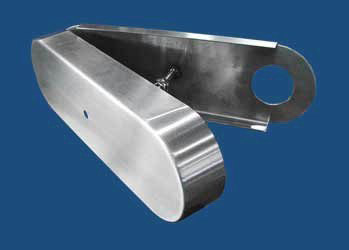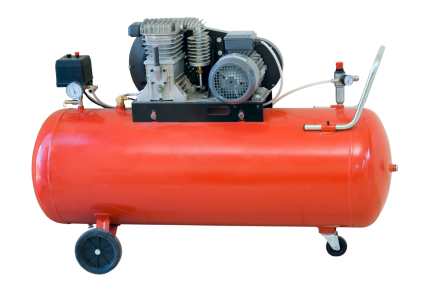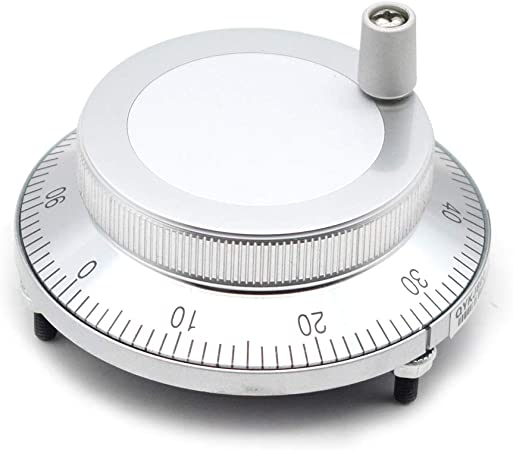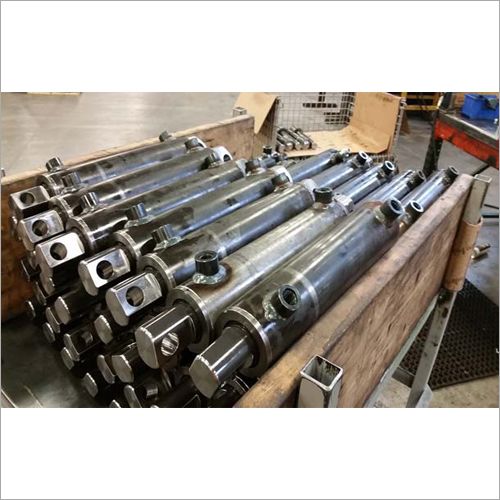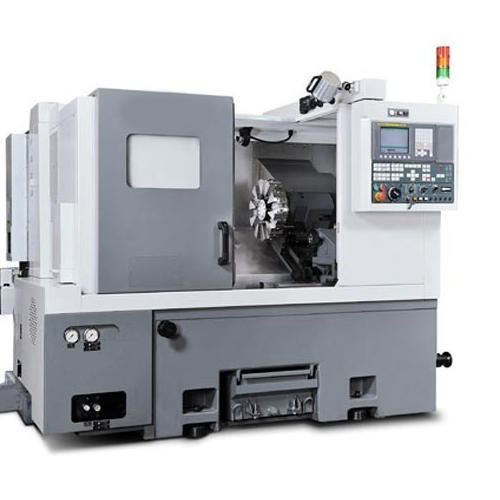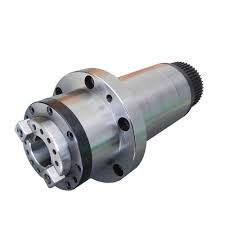Hydraulic cylinders get their power from pressurized hydraulic fluid, which is typically oil. The hydraulic cylinder consists of a cylinder barrel, in which a piston connected to a piston rod moves back and forth. The barrel is closed on one end by the cylinder bottom and the other end by the cylinder head where the piston rod comes out of the cylinder. The piston has sliding rings and seals. The piston divides the inside of the cylinder into two chambers, the bottom chamber and the piston rod side chamber .
A hydraulic cylinder is the actuator or “motor” side of this system. The “generator” side of the hydraulic system is the hydraulic pump which delivers a fixed or regulated flow of oil to the hydraulic cylinder, to move the piston. The piston pushes the oil in the other chamber back to the reservoir.
Parts of a Hydraulic cylinder
A hydraulic cylinder has the following parts:
Cylinder barrel
The main function of the cylinder body is to hold cylinder pressure. The cylinder barrel is mostly made from honed tubes. Honed tubes are produced from Suitable To Hone Steel Cold Drawn Seamless Tubes (CDS tubes) or Drawn Over Mandrel (DOM) tubes. Honed tubing is ready to use for hydraulic cylinders without further ID processing. The surface finish of the cylinder barrel is typically 4 to 16 microinch.Honing process and Skiving & Roller burnishing (SRB) process are the two main types of processes for manufacturing cylinder tube.The piston reciprocates in the cylinder.The cylinder barrel has features of smooth inside surface,high precision tolerance, durable in use etc.
Cylinder base or cap
The main function of the cap is to enclose the pressure chamber at one end. The cap is connected to the body by means of welding, threading, bolts, or tie rod. Caps also perform as cylinder mounting components [cap flange, cap trunnion, cap clevis]. Cap size is determined based on the bending stress. A static seal/o ring is used in between cap and barrel (except welded construction).
Cylinder head
The main function of the head is to enclose the pressure chamber from the other end. The head contains an integrated rod sealing arrangement or the option to accept a seal gland. The head is connected to the body by means of threading, bolts, or tie rod. A static seal/o ring is used in between head and barrel.
Piston
The main function of the piston is to separate the pressure zones inside the barrel. The piston is machined with grooves to fit elastomeric or metal seals and bearing elements. These seals can be single acting or double acting. The difference in pressure between the two sides of the piston causes the cylinder to extend and retract. The piston is attached with the piston rod by means of threads, bolts, or nuts to transfer the linear motion.
Piston rod
The piston rod is typically a hard chrome-plated piece of cold-rolled steel which attaches to the piston and extends from the cylinder through the rod-end head. In double rod-end cylinders, the actuator has a rod extending from both sides of the piston and out both ends of the barrel. The piston rod connects the hydraulic actuator to the machine component doing the work. This connection can be in the form of a machine thread or a mounting attachment. The piston rod is highly ground and polished so as to provide a reliable seal and prevent leakage.
Seal gland
The cylinder head is fitted with seals to prevent the pressurized oil from leaking past the interface between the rod and the head. This area is called the seal gland. The advantage of a seal gland is easy removal and seal replacement. The seal gland contains a primary seal, a secondary seal / buffer seal, bearing elements, wiper / scraper and static seal. In some cases, especially in small hydraulic cylinders, the rod gland and the bearing elements are made from a single integral machined part.
Seals
The seals are considered / designed as per the cylinder working pressure, cylinder speed, operating temparature , working medium and application. Piston seals are dynamic seals, and they can be single acting or double acting. Generally speaking, Elastomer seals made from nitrile rubber, Polyurethane or other materials are best in lower temperature environments, while seals made of Fluorocarbon Viton are better for higher temperatures. Metallic seals are also available and commonly use cast iron for the seal material. Rod seals are dynamic seals and generally are single acting. The compounds of rod seals are nitrile rubber Polyurethane, or Fluorocarbon Viton . Wipers / scrapers are used to eliminate contaminants such as moisture, dirt, and dust, which can cause extensive damage to cylinder walls, rods, seals and other components. The common compound for wipers is polyurethane. Metallic scrapers are used for sub zero temperature applications, and applications where foreign materials can deposit on the rod. The bearing elements / wear bands are used to eliminate metal to metal contact. The wear bands are designed as per the side load requirements. The primary compounds used for wear bands are filled PTFE , woven fabric reinforced polyester resin and bronze
Other parts
There are many component parts that make up the internal portion of a hydraulic cylinder. All of these pieces combine to create a fully functioning component.
- Cylinder base connection
- Cushions
- Internal Threaded Ductile Heads
- Head Glands
- Polypak Pistons
- Cylinder Head Caps
- Butt Plates
- Eye Brackets/Clevis Brackets
- MP Detachable Mounts
- Rod Eyes/Rod Clevis
- Pivot Pins
- Spherical Ball Bushings
- Spherical Rod Eye
- Alignment Coupler
- Ports and Fittings
Single acting vs. double acting
- Single acting cylinders are economical and the simplest design. Hydraulic fluid enters through a port at one end of the cylinder, which extends the rod by means of area difference. An external force, internal retraction spring or gravity returns the piston rod.
- Double acting cylinders have a port at each end or side of the piston, supplied with hydraulic fluid for both the retraction and extension.
Designs
There are primarily two main styles of hydraulic cylinder construction used in industry: tie rod style cylinders and welded body style cylinders.
Tie rod cylinder
A tie rod cylinder
Tie rod style hydraulic cylinders use high strength threaded steel rods to hold the two end caps to the cylinder barrel. They are most often seen in industrial factory applications. Small bore cylinders usually have 4 tie rods, and large bore cylinders may require as many as 16 or 20 tie rods in order to retain the end caps under the tremendous forces produced. Tie rod style cylinders can be completely disassembled for service and repair, and they are not always customizable.
The National fluid power assotation (NFPA) has standardized the dimensions of hydraulic tie rod cylinders. This enables cylinders from different manufacturers to interchange within the same mountings.
Welded body cylinder
Welded body cylinders have no tie rods. The barrel is welded directly to the end caps. The ports are welded to the barrel. The front rod gland is usually threaded into or bolted to the cylinder barrel. That allows the piston rod assembly and the rod seals to be removed for service.A Cut Away of a Welded Body Hydraulic Cylinder showing the internal components
Welded body cylinders have a number of advantages over tie rod style cylinders. Welded cylinders have a narrower body and often a shorter overall length enabling them to fit better into the tight confines of machinery. Welded cylinders do not suffer from failure due to tie rod stretch at high pressures and long strokes. The welded design also lends itself to customization. Special features are easily added to the cylinder body, including special ports, custom mounts, valve manifolds, and so on.
The smooth outer body of welded cylinders also enables the design of multi-stage telescopic cylinders.
Welded body hydraulic cylinders dominate the mobile hydraulic equipment market such as construction equipment and material handling equipment (forklift trucks, telehandlers, and lift-gates). They are also used by heavy industry in cranes, oil rigs, and large off-road vehicles for above-ground mining operations.
Piston rod construction
The piston rod of a hydraulic cylinder operates both inside and outside the barrel, and consequently both in and out of the hydraulic fluid and surrounding atmosphere.
Coatings
Wear and corrosion resistant surfaces are desirable on the outer diameter of the piston rod. The surfaces are often applied using coating techniques such as Chrome (Nickel) Plating, Lunac 2+ duplex, Laser Cladding, PTA welding and Thermal Spraying. These coatings can be finished to the desirable surface roughness (Ra, Rz) where the seals give optimum performance. All these coating methods have their specific advantages and disadvantages. It is for this reason that coating experts play a crucial role in selecting the optimum surface treatment procedure for protecting Hydraulic Cylinders.
Cylinders are used in different operational conditions and that makes it a challenge to find the right coating solution. In dredging there might be impact from stones or other parts, in salt water environments there are extreme corrosion attacks, in off-shore cylinders facing bending and impact in combination with salt water, and in the steel industry there are high temperatures involved, etc. There is no single coating solution which successfully combats all the specific operational wear conditions. Every technique has its own benefits and disadvantages.
Length
Piston rods are generally available in lengths which are cut to suit the application. As the common rods have a soft or mild steel core, their ends can be welded or machined for a screw thread.
Distribution of forces on components
The forces on the piston face and the piston head retainer vary depending on which piston head retention system is used.
If a circlip (or any non preloaded system) is used, the force acting to separate the piston head and the cylinder shaft shoulder is the applied pressure multiplied by the area of the piston head. The piston head and shaft shoulder will separate and the load is fully reacted by the piston head retainer.
If a preloaded system is used the force between the cylinder shaft and piston head is initially the piston head retainer preload value. Once pressure is applied this force will reduce. The piston head and cylinder shaft shoulder will remain in contact unless the applied pressure multiplied by piston head area exceeds the preload.
The maximum force the piston head retainer will see is the larger of the preload and the applied pressure multiplied by the full piston head area. The load on the piston head retainer is greater than the external load, which is due to the reduced shaft size passing through the piston head. Increasing this portion of shaft reduces the load on the retainer.
Side loading
Side loading is unequal pressure that is not centered on the cylinder rod. This off-center strain can lead to bending of the rod in extreme cases, but more commonly causes leaking due to warping the circular seals into an oval shape. It can also damage and enlarge the bore hole around the rod and the inner cylinder wall around the piston head, if the rod is pressed hard enough sideways to fully compress and deform the seals to make metal-on-metal scraping contact.
The strain of side loading can be directly reduced with the use of internal stop tubes which reduce the maximum extension length, leaving some distance between the piston and bore seal, and increasing leverage to resist warping of the seals. Double pistons also spread out the forces of side loading while also reducing stroke length. Alternately, external sliding guides and hinges can support the load and reduce side loading forces applied directly on the cylinder.
Repair
Hydraulic cylinders form the heart of many hydraulic systems. It is a common practice to dissemble and rebuild an entire device in the case of hydraulic cylinder repair. Inspection of the leakage issue and scrutinizing cylinder parts (especially the seals) is helpful in recognizing the exact problem and choosing the repair options accordingly. Steps involved in the repair of hydraulic cylinders:
Disassembly
First of all, you should place the cylinder in a suitable location, which has sufficient space to work. If you are working in a cluttered space, it will be difficult for you to keep track of opened up parts. After bringing the cylinder to an appropriate spot, open the cylinder ports and drain out all the hydraulic fluid. The cover of cylinder can be removed by unscrewing the bolts. Once you take off the cover, remove the piston by loosening the input valves.
Diagnosis
Once the piston is completely removed, you will be able to see multiple seals on different parts that are connected to the piston rod . First of all, you need to examine the piston rod to see if there is any damage. If the shaft of the rod is bent or if the cylinder bore has scratches, then get them repaired at a professional repair shop. If the damage is permanent, then you can order or manufacture a new piston rod for your hydraulic cylinder. Piston seals can get damaged, be distorted, or worn. Such damaged seals can cause leakage of hydraulic fluid from the cylinder leading to lower overall pressure or inability to hold pressure. When such events occur, you know that these seals need to be replaced.
Repairing or replacing damaged parts
The parts of the hydraulic cylinder that are distorted (piston rod, rod seal, piston seal and/ or head of rod), need to be either repaired or completely replaced with new parts. The seals can be repacked with the help of a hydraulic cylinder seal kit. These kits will have seals and suitable o-rings. Remember the size and type of old seal while removing them and fix the new ones accordingly. Make sure that you handle the new seals with utmost care so that they do not get damaged in any way.
Rebuilding
Before reassembling all the parts of your cylinder, you should clean and dry the cylinder barrel completely. Also clean the piston rod, shaft, and other parts of the cylinder. Get the broken and damaged seals repacked. Then assemble the parts back on the piston rod. The assembly needs to be done in a reverse order. Once you have assembled all the parts back, put the rod into the soft-jaw vise and screw back the bolts onto the piston rod.
Important tip
If the parts of the hydraulic cylinder are severely damaged, then it is advisable to replace them with new parts with the help of a professional repair expert. Trying to replace/ repair too many parts on your own can lead to faulty reassembly. By following the above steps, you can accomplish the task of hydraulic cylinder repair. Make sure that you prevent ingress of moisture or dirt after assembly of the parts is done.
Cylinder mounting methods
Mounting methods also play an important role in cylinder performance. Generally, fixed mounts on the centerline of the cylinder are best for straight line force transfer and avoiding wear. Common types of mounting include:
Flange mounts—Very strong and rigid, but have little tolerance for misalignment. Experts recommend cap end mounts for thrust loads and rod end mounts where major loading puts the piston rod in tension. Three types are head rectangular flange, head square flange or rectangular head. Flange mounts function optimally when the mounting face attaches to a machine support member.
Side-mounted cylinders—Easy to install and service, but the mounts produce a turning moment as the cylinder applies force to a load, increasing wear and tear. To avoid this, specify a stroke at least as long as the bore size for side mount cylinders (heavy loading tends to make short stroke, large bore cylinders unstable). Side mounts need to be well aligned and the load supported and guided.
Centerline lug mounts —Absorb forces on the centerline, and require dowel pins to secure the lugs to prevent movement at higher pressures or under shock conditions. Dowel pins hold it to the machine when operating at high pressure or under shock loading.
Pivot mounts —Absorb force on the cylinder centerline and let the cylinder change alignment in one plane. Common types include clevises, trunnion mounts and spherical bearings. Because these mounts allow a cylinder to pivot, they should be used with rod-end attachments that also pivot. Clevis mounts can be used in any orientation and are generally recommended for short strokes and small- to medium-bore cylinders.
Special hydraulic cylinders
Telescopic cylinder
The length of a hydraulic cylinder is the total of the stroke, the thickness of the piston, the thickness of bottom and head and the length of the connections. Often this length does not fit in the machine. In that case the piston rod is also used as a piston barrel and a second piston rod is used. These kinds of cylinders are called telescopic cylinder. If we call a normal rod cylinder single stage, telescopic cylinders are multi-stage units of two, three, four, five or more stages. In general telescopic cylinders are much more expensive than normal cylinders. Most telescopic cylinders are single acting (push). Double acting telescopic cylinders must be specially designed and manufactured.
Plunger cylinder
A hydraulic cylinder without a piston or with a piston without seals is called a plunger cylinder. A plunger cylinder can only be used as a pushing cylinder; the maximum force is piston rod area multiplied by pressure. This means that a plunger cylinder in general has a relatively thick piston rod.
Differential cylinder
A differential cylinder acts like a normal cylinder when pulling. If the cylinder however has to push, the oil from the piston rod side of the cylinder is not returned to the reservoir, but goes to the bottom side of the cylinder. In such a way, the cylinder goes much faster, but the maximum force the cylinder can give is like a plunger cylinder. A differential cylinder can be manufactured like a normal cylinder, and only a special control is added.
The above differential cylinder is also called a regenerative cylinder control circuit. This term means that the cylinder is a single rod, double acting hydraulic cylinder. The control circuit includes a valve and piping which during the extension of the piston, conducts the oil from the rod side of the piston to the other side of the piston instead of to the pump’s reservoir. The oil which is conducted to the other side of the piston is referred to as the regenerative oil.
Position sensing “smart” hydraulic cylinder
Position sensing hydraulic cylinder eliminate the need for a hollow cylinder rod. Instead, an external sensing “bar” using Hall effect technology senses the position of the cylinder’s piston. This is accomplished by the placement of a permanent magnet within the piston. The magnet propagates a magnetic field through the steel wall of the cylinder, providing a locating signal to the sensor.
Terminology
In the United States, popular usage refers to the whole assembly of cylinder, piston, and piston rod (or more) collectively as a “piston”, which is incorrect. Instead, the piston is the short, cylindrical metal component that separates the two parts of the cylinder barrel internally.
You depend on hydraulic cylinders to help you deliver essential goods and services to your customers. Faulty cylinders translate into downtime. That’s lost money and time that you and those who depend on you can’t afford. When you need hydraulic cylinder repair, it makes sense to count on a company with a track record of high-quality repairs, reliable service and effective solutions. We delivers: dependable, rigorously-tested hydraulic repair, hydraulic pump repair and more that end downtime and return your production processes to peak efficiency.
- Single or double end
- Repair / replacement of rods, seals, piston heads, gland nuts, and tubes
- Any diameter up to 14″ and lengths to 18′
- Pressure testing after repair to 3,000 psi
- Replacement seals rated up to 6,000 psi and 500 deg F
All hydraulic cylinders received for repair are disassembled, all components cleaned and inspected, rods are measured for straightness and wear. tubes are measured for wear and the seal / wear band grooves are measured and inspected.
All hydraulic cylinder repairs are dynamically tested to verify proper operation and leak free performance.
Expert Hydraulic Cylinder Repair
Cylinders are what is known as a “linear” actuator. Their basic operation is to move something in and out or up and down. The particular cylinder below is a “tie rod” type cylinders with “trunions” so that it can can pivot in it’s application. This cylinder is also an “oil or hydraulic” cylinder. The two basic cylinder configurations are “tie rod” and “mill” types. A tie rod cylinder has it’s end cap and seal gland cap held to the tube via tie rods. A mill cylinder has no end cap because it is a welded construction with the seal gland normally a screw in configuration. Cylinders can be used with oil, air, or water depending on their application and design. They also come in numerous shapes and sizes (bore and stroke) depending on their application.
You can find cylinders in virtually all industries. Another place to look in in the mobile industry. Large cylinders are used as shock absorbers on the large Quarry or Mining trucks, and on bulldozers, endloaders, etc. for various functions. They can also be found in the entertainment industry.
Accountability and Reliability
From the moment you contact K+S Services for hydraulic cylinder repair services, we dedicate our efforts to ensuring that you receive your parts back in exceptional working condition. The result is a cylinder that meets or exceeds OEM specifications and performs according to its original pressure rating. Our included Repair and Testing Report is complete with several key details for your review:
- Problems identified
- Parts repair or replaced
- Testing details, duration and results
- Probable root cause of failure
- Recommended installation instructions
Some of the Hydraulic Cylinder and Servo Actuator brands we service and repair include: Anker-Holth, Boxtel-Holland, Caterpillar, Graco, Hanna, Hydroline, Instrom, Kress, Komatsu, Lynair, Miller Milwaukee, MTS, Moog, Nopak, Rexroth, Sheffer, Tomkins and more.Contact Us
Top 5 Hydraulic Cylinder Repair Tips
Hydraulic cylinders are an integral part of the hydraulic system. They are a mechanical actuator that provides the unidirectional force. Integration of hydraulic cylinders will eliminate the presence of levers and gears. Both mobile(hydraulic presses, cranes, forges, and packing machines) and industrial systems(agricultural machines, construction vehicles, marine equipment) utilize hydraulic systems. Among them, most of the application use hydraulic cylinders for lifting, picking and gripping.
Every hydraulic system will contain basic components like pumps, cylinders, valves, filters, etc.. Hydraulic cylinder is one of the least complicated components in the list. So, they are easy to repair and maintain. A person having basic knowledge about the hydraulic system can perform hydraulic cylinder repairing. Before explaining the repairing of cylinders, I will give you brief details on the causes of hydraulic cylinder failure. Damage of seals is a common reason that creates hydraulic cylinder damage. Seal damage occurs as a result of the incorrect fitting, corrosion, inappropriate metalwork clearance, etc. Fluid contamination will damage the piston rod or seal surface. Improper alignment of cylinder and load will damage the rod bearings or piston rods. An internally corroded barrel will contaminate the fluid inside it. Extreme temperature and chemical attack are the other reasons for failure.
Before performing the repairing, clean the surface properly and disconnect the hoses and plugs attached to it. After disconnecting the parts, drain all the fluid present inside the cylinder. Now, let’s begin the repairing of the hydraulic system. For that we need tools. Proper seal kit, rubber mallet, screwdriver, punch, pliers, emery cloth, and torque wrench are the tools required for repairing. Leaking hydraulic cylinder is the most common issue that results in cylinder repair. Disassembly of the cylinder, diagnosing the cause of failure, repairing or replacing faulty components, and rebuilding the cylinder are the steps involved in cylinder repairing. During the process of hydraulic cylinder repairing, always consider the below-mentioned cylinder repair tips.
- If you disassemble the hydraulic cylinder as a part of repairing, inspect not only the failed part also perform a thorough inspection of all other components.
- Hydraulic wear bands(also called wear bush or guide ring) are used for guiding pistons. So, don’t forget to assemble the wear band because this will reduce the metal-to-metal contact.
- Premature failure of rod seals indicates the bend on the rod.
- Metal tools will scratch the surface of the cylinder and will create problems like corrosion. So always choose the best-fit tools for repairing.
- Larger hydraulic cylinders use high tension springs to perform operations. So, if you are an inexperienced worker, be careful while handling such cylinders.
- For replacing seals, don’t measure the existing size of the seal. It will expand or compress according to the environmental condition.
If you have any enquiries about hydraulic cylinder u can contact us at any time in a week we are reapiring cnc machines,Telescopic covers Repair ,Bellow covers Repair ,Appron cover Repair .Roll way cover Repair ,Hydarulic cylinders Repair ,Mechanical parts repair, Mavhine Spindle Repair , Ball screw Repair,Guideway Repair ,Lubrication Pump Repair ,Hydaulic cylinder Repair, CNC Machine Repair sevice ,VMC Machine Repair service,Preventive Maintenace service,HMC Machine repair service,Index table repair service,Rotary table repair service,Coolant pump repair service ,Counter balancing cylinder repair service,Panel ac repair service in Hoshiarpur,Jalandhar,Phagwara,Goraya,Ludhiana,Amritsar,Tarantaran,Patti,Batala,Gurdaspur,Pathankot,Jammu,Mukerian,Dasuya,Tanda,Gagret,Una,Baddi,Nangal,Tahliwal,Garhshankar,Anandpur sahib,Ropar,Nawansahar,Mandi gobindgarh, khanna,Moahli,Chandigarh,Nalagarh,Nasrala,Samarala,Rajpura,Patiala,Nabha,Malerkotla ,Bathinda,Moga,Firozpur and in all punjab and india.
Contact +91 7888776715,9915759967.

